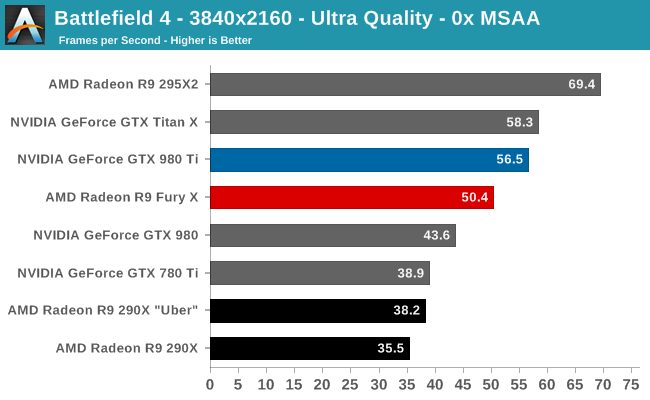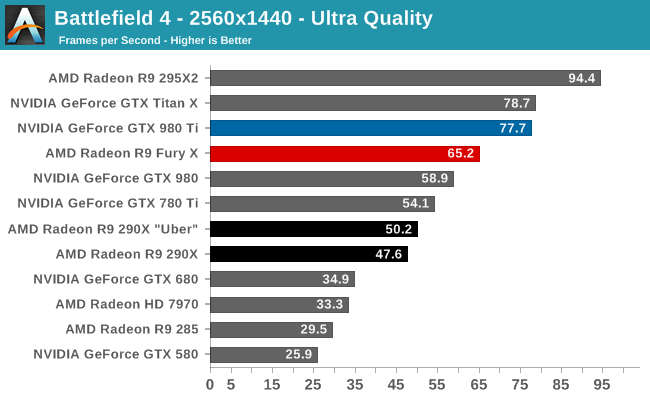The AMD Radeon R9 Fury X Review: Aiming For the Top
by Ryan Smith on July 2, 2015 11:15 AM ESTBattlefield 4
Kicking off our benchmark suite is Battlefield 4, DICE’s 2013 multiplayer military shooter. After a rocky start, Battlefield 4 has since become a challenging game in its own right and a showcase title for low-level graphics APIs. As these benchmarks are from single player mode, based on our experiences our rule of thumb here is that multiplayer framerates will dip to half our single player framerates, which means a card needs to be able to average at least 60fps if it’s to be able to hold up in multiplayer.



As we briefly mentioned in our testing notes, our Battlefield 4 testing has been slightly modified as of this review to accommodate the changes in how AMD is supporting Mantle. This benchmark still defaults to Mantle for GCN 1.0 and GCN 1.1 cards (7970, 290X), but we’re using Direct3D for GCN 1.2 cards like the R9 Fury X. This is due to the lack of Mantle driver optimizations on AMD’s part, and as a result the R9 Fury X sees poorer performance here, especially at 2560x1440 (65.2fps vs. 54.3fps).
In any case, regardless of the renderer you pick, our first test does not go especially well for AMD and the R9 Fury X. The R9 Fury X does not take the lead at any resolution, and in fact this is one of the worse games for the card. At 4K AMD trails by 8-10%, and at 1440p that’s 16%. In fact the latter is closer to the GTX 980 than it is the GTX 980 Ti. Even with the significant performance improvement from the R9 Fury X, it’s not enough to catch up to NVIDIA here.
Meanwhile the performance improvement over the R9 290X “Uber” stands at between 23% and 32% depending on the resolution. AMD not only scales better than NVIDIA with higher resolutions, but R9 Fury X is scaling better than R9 290X as well.










458 Comments
View All Comments
TallestJon96 - Sunday, July 5, 2015 - link
This card and the 980 ti meet two interesting milestones in my mind. First, this is the first time 1080p isn't even considered. Pretty cool to be at the point where 1080p is considered at bit of a low resolution for high end cards.Second, it's the point where we have single cards can play games at 4k, with higher graphical settings, and have better performance than a ps4. So at this point, if a ps4 is playable, than 4k gaming is playable.
It's great to see higher and higher resolutions.
XtAzY - Sunday, July 5, 2015 - link
Geez these benchies are making my 580 looking ancient.MacGyver85 - Sunday, July 5, 2015 - link
Idle power does not start things off especially well for the R9 Fury X, though it’s not too poor either. The 82W at the wall is a distinct increase over NVIDIA’s latest cards, and even the R9 290X. On the other hand the R9 Fury X has to run a CLLC rather than simple fans. Further complicating factors is the fact that the card idles at 300MHz for the core, but the memory doesn’t idle at all. HBM is meant to have rather low power consumption under load versus GDDR5, but one wonders just how that compares at idle.I'd like to see you guys post power consumption numbers with power to the pump cut at idle, to answer the questions you pose. I'm pretty sure the card is competitive without the pump running (but still with the fan to have an equal comparison). If not it will give us more of an insight in what improvements AMD can give to HBM in the future with regards to power consumption. But I'd be very suprised if they haven't dealt with that during the design phase. After all, power consumption is THE defining limit for graphics performance.
Oxford Guy - Sunday, July 5, 2015 - link
Idle power consumption isn't the defining limit. The article already said that the cooler keeps the temperature low while also keeping noise levels in check. The result of keeping the temperature low is that AMD can more aggressively tune for performance per watt.Oxford Guy - Sunday, July 5, 2015 - link
This is a gaming card, not a card for casuals who spend most of their time with the GPU idling.Oxford Guy - Sunday, July 5, 2015 - link
The other point which wasn't really made in the article is that the idle noise is higher but consider how many GPUs exhaust their heat into the case. That means higher case fan noise which could cancel out the idle noise difference. This card's radiator can be set to exhaust directly out of the case.mdriftmeyer - Sunday, July 5, 2015 - link
It's an engineering card as much as it is for gaming. It's a great solid modeling card with OpenCL. The way AMD is building its driver foundation will pay off big in the next quarter.Nagorak - Monday, July 6, 2015 - link
I don't know that I agree about that. Even people who game a lot probably use their computer for other things and it sucks to be using more watts while idle. That being said, the increase is not a whole lot.Oxford Guy - Thursday, July 9, 2015 - link
Gaming is a luxury activity. People who are really concerned about power usage would, at the very least, stick with a low-wattage GPU like a 750 Ti or something and turn down the quality settings. Or, if you really want to be green, don't do 3D gaming at all.MacGyver85 - Wednesday, July 15, 2015 - link
That's not really true. I don't mind my gfx card pulling a lot of power while I'm gaming. But I want it to sip power when it's doing nothing. And since any card spends most of its time idling, idling is actually very important (if not most important) in overal (yearly) power consumption.Btw I never said that idle power consumption is the defining limit, I said power consumption is the defining limit. It's a give that any Watt you save while idling is generally a Watt of extra headroom when running at full power. The lower the baseline load the more room for actual, functional (graphics) power consumption. And as it turns out I was right in my assumption that the actual graphics card minus the cooler pump idle power consumption is competitive with nVidia's.